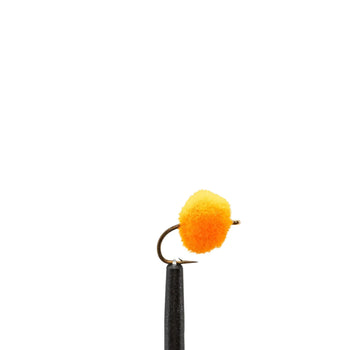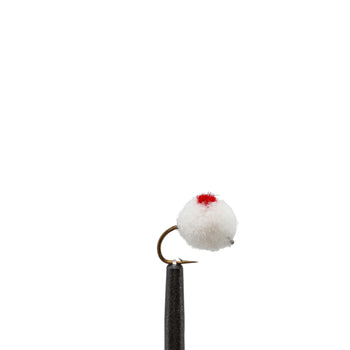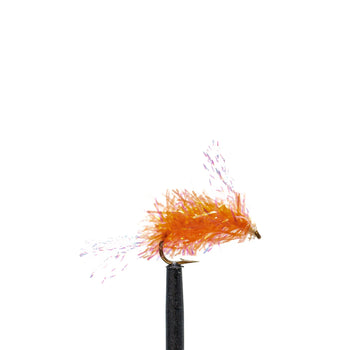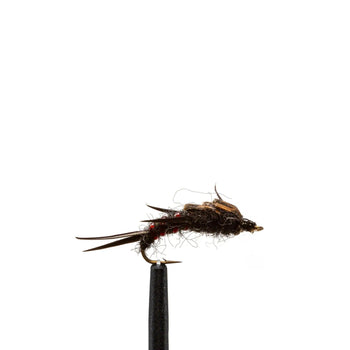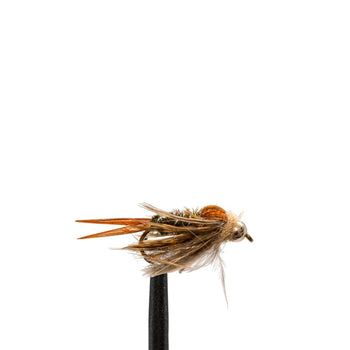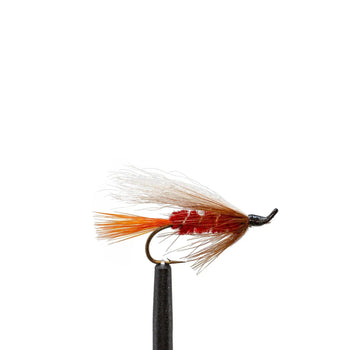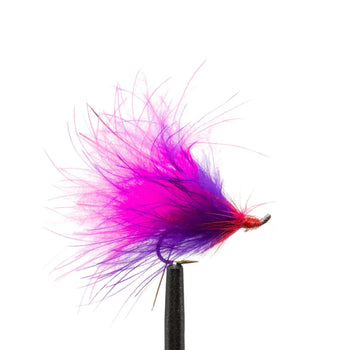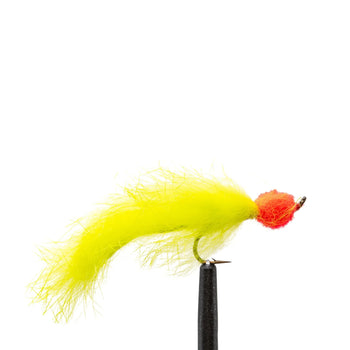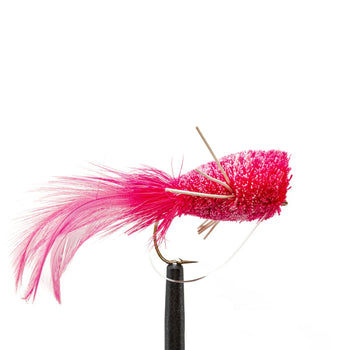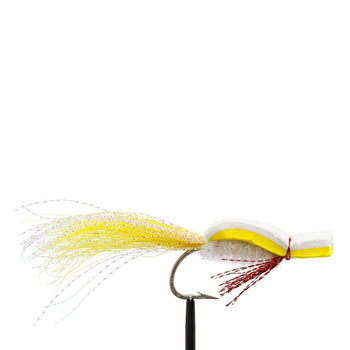Steelhead Flies – A Comprehensive Guide to Catching the Chromers

Steelhead fishing is a pursuit that combines the thrill of the chase with the artistry of fly tying. These elusive, sea-run rainbow trout are known for their strength, speed, and acrobatics, making them one of the most sought-after game fish for fly anglers. To consistently hook into these chrome rockets, you need the right flies, techniques, and an understanding of why they work. In this month's Fly of the Month, we’ll dive into the most popular steelhead flies, how to fish them, and the science behind their effectiveness.
What Are Steelhead Fly Patterns?
Steelhead fly patterns are specialized flies designed to imitate the natural prey of steelhead or trigger their predatory instincts. These flies are crafted to match the conditions of the rivers and streams where steelhead are found, as well as the behaviors of the fish during different stages of their life cycle. Steelhead flies can range from simple, sparse patterns to intricate, highly detailed creations, but they all share a common goal: to entice a strike from these powerful fish.
Steelhead flies are typically categorized into four main types:
-
Egg Patterns: Mimic salmon or trout eggs, a high-calorie food source for steelhead.
-
Nymphs and Stoneflies: Imitate aquatic insects that steelhead encounter in freshwater.
-
Swing Flies: Designed to be fished across the current, mimicking baitfish or leeches.
-
Dry Flies and Skaters: Fished on the surface to imitate insects or provoke aggressive strikes.
Each category serves a specific purpose and is effective under different conditions. Understanding the nuances of these patterns will help you choose the right fly for the situation.

Categories of Steelhead Flies
1. Egg Patterns
Egg patterns are arguably the most effective and widely used steelhead flies. Steelhead are opportunistic feeders, and during their spawning runs, they often key in on salmon eggs drifting downstream. Egg patterns mimic these eggs, making them irresistible to steelhead.
Featured Patterns:
-
Glo Bug (Sizes 8-10): A classic egg pattern with a vibrant orange hue that mimics salmon eggs. Suggested colors: steelhead orange, dead egg, and cherise. Dead drift this fly near the bottom in seams and tailouts for the best results.
-
Sucker Spawn - White / Red Dot (Sizes 8-10): A sucker spawn pattern with a white body and red dot, perfect for imitating trout or sucker eggs. Fish it in slower water where steelhead hold.
-
Estaz Egg - Salmon Candy (Size 6): A flashy, UV-enhanced egg pattern that stands out in murky water. Suggested colors: orange, cherise, and chartreuse. Use this in high, stained water conditions for maximum visibility.
How to Fish Them:
-
Dead drift egg patterns under an indicator or tight-line them close to the bottom.
-
Use light tippet (4-6 lb) to ensure a natural presentation.
-
Focus on seams, tailouts, and slower water where steelhead hold.
Why They Work: Steelhead are hardwired to recognize eggs as a high-calorie food source. Even if they’re not actively feeding, they’ll often strike out of instinct.
2. Nymphs and Stoneflies
Nymphs and stonefly patterns imitate the aquatic insects that steelhead encounter in their freshwater habitats. These flies are particularly effective in rivers with abundant insect life.
Featured Patterns:
-
Beadhead Flashback Stone - Black (Sizes 6-8): A weighted stonefly pattern with a flashback rib for added visibility. Fish this near the bottom in deeper pools and runs.
-
Mark's Stonefly - Brown (Sizes 6-8): A realistic stonefly imitation with a brown rubber body and lifelike legs. Perfect for targeting steelhead in rocky, fast-moving water.
-
Kaufmann's Stonefly - Black (Sizes 6-8): A classic stonefly pattern with a black rubber body and weighted head for getting deep. Fish this in faster currents and riffles.
- 20 Incher (Sizes 6-8): A large, articulated stonefly pattern that’s perfect for big, aggressive steelhead. Use this in deeper pools and runs for maximum impact.
How to Fish Them:
-
Fish nymphs under an indicator or as part of a Euro-nymphing rig.
-
Use split shot to get the fly down to the fish’s level.
-
Target deeper pools and runs where steelhead rest.
Why They Work: Nymphs represent a natural food source for steelhead, especially in slower-moving water where insects are abundant.
3. Swing Flies (Spey and Traditional Flies)
Swing flies are designed to be fished across the current, imitating baitfish, leeches, or other larger prey. These flies are a favorite among two-handed Spey casters and traditional wet fly anglers.
Featured Patterns:
-
Thor (Sizes 2-4): A flashy, articulated intruder pattern with marabou and synthetic materials for maximum movement. Swing this fly across the current to trigger aggressive strikes.
-
Popsicle (Sizes 2-4): A classic steelhead fly with a vibrant pink and white color scheme that mimics baitfish. Perfect for swinging in faster water.
-
Egg-Sucking Leech (Sizes 4-6): A deadly pattern that combines an egg imitation with a leech-like body, perfect for triggering aggressive strikes. Suggested colors: black, purple, and olive. Fish this with a slow, steady retrieve or swing it across the current.
- Egg-Sucking Bunny (Sizes 4-6): A unique pattern that combines an egg imitation with a leech-like body, perfect for triggering aggressive strikes. Suggested colors: pink, orange, and chartreuse. Swing this fly in slower pools and tailouts.
How to Fish Them:
-
Cast across the current and let the fly swing through the water column.
-
Use a sinking tip or full sinking line to get the fly down.
-
Vary your retrieve speed to trigger strikes.
Why They Work: Swing flies trigger the predatory instinct of steelhead, especially in faster water or when fish are aggressive. The movement and flash of these flies mimic wounded prey, making them hard to resist.
4. Dry Flies and Skaters
While less common, dry fly fishing for steelhead can be incredibly exciting. Skaters and dry flies are fished on the surface, imitating insects or other prey. This method is most effective during low-water conditions or when steelhead are actively surface feeding.
Featured Patterns:
-
Pink Pollywog (Sizes 6-8): A buoyant, high-visibility dry fly with a pink foam body that’s perfect for low-water steelhead. Skitter this fly across the surface to provoke explosive strikes.
-
Gurgler (Sizes 4-6): A surface fly that creates a popping action to provoke aggressive strikes. Suggested colors: black, olive, yellow, and white. Use a twitch-and-pause retrieve for best results.
- Royal Chubby Chernobyl (Sizes 6-8): A large, buoyant dry fly with a rubber leg action that’s perfect for skittering across the surface. Fish this in slower pools and tailouts where steelhead are likely to rise.
How to Fish Them:
-
Cast upstream or across and let the fly drift naturally.
-
Use a twitch-and-pause retrieve (also called (skittering) to create surface disturbance .
-
Focus on slower pools and tailouts where steelhead are likely to rise.
Why They Work: Dry flies and skaters trigger a territorial or aggressive response from steelhead. The sight of a struggling insect or prey item on the surface can provoke explosive strikes.
How to Fish with Steelhead Flies Effectively
Fishing for steelhead requires a combination of skill, patience, and strategy. Here are some tips to help you fish steelhead flies effectively:
1. Understand the Water
-
High Water: In high, murky conditions, use larger, brighter flies like Intruders or egg patterns. The increased visibility of these flies helps steelhead locate them in the turbid water.
-
Low Water: In low, clear conditions, switch to smaller, more natural patterns like nymphs or subtle swing flies. Stealth and precision are key in these conditions.
2. Master Your Presentation
-
Dead Drift: For egg patterns and nymphs, a drag-free drift is essential. Use an indicator or tight-line technique to keep your fly in the strike zone.
-
Swinging Flies: When fishing swing flies, cast across the current and let the fly swing through the water column. Vary your retrieve speed to find what triggers strikes.
-
Surface Action: For dry flies and skaters, focus on creating subtle surface disturbances. A twitch-and-pause retrieve can provoke aggressive strikes.
3. Adjust Your Depth
-
Steelhead often hold near the bottom, so it’s crucial to get your fly down to their level. Use split shot, sinking tips, or full sinking lines to achieve the right depth.
4. Be Patient and Persistent
-
Steelhead are known as the “fish of a thousand casts” for a reason. Stay focused, work the water thoroughly, and don’t be afraid to experiment with different flies and techniques.
5. Pay Attention to Fly Color and Size
-
Steelhead can be picky, so carry a variety of colors and sizes. Bright colors like pink and orange are great for murky water, while natural tones like black and olive work well in clear conditions.
Why Steelhead Flies Work: The Science Behind the Success
Steelhead are opportunistic predators with a mix of instinctual and learned behaviors. Their strikes are often triggered by:
-
Instinct: During spawning runs, steelhead are not actively feeding but will still strike out of instinct (e.g., egg patterns).
-
Aggression: Swing flies and skaters provoke territorial or predatory responses.
-
Curiosity: Subtle patterns like nymphs can entice steelhead to investigate and strike.
By understanding these behaviors and matching your fly choice to the conditions, you can increase your chances of hooking into these magnificent fish.
Product Recommendation: Kenai River Combo Kit
If you’re looking for a reliable, high-performance setup to target steelhead, the Kenai River Combo Kit from Jackson Hole Fly Company is an excellent choice. This kit is designed specifically for anglers chasing powerful fish like steelhead and salmon, making it a perfect match for your steelhead adventures.
What’s Included:
-
9'0" 8WT 4-Piece Silvertip Traveler Fly Rod: A medium-action rod crafted from reliable IM6 graphite, offering a blend of sensitivity and strength.
-
7/8WT Yellowstone Grizzly Fly Reel: A CNC-machined aluminum reel with a large arbor for faster line retrieval and a fully-sealed drag clutch bearing for smooth, dependable performance.
-
8WT Silvertip 10' Sink Tip Weight Forward Fly Line: Perfect for streamer fishing, this line features a 10' sinking tip with a 1.5 ips sink rate, ideal for flowing water.
-
20lb Dacron Backing: Durable and reliable backing to handle hard-running fish.
-
0X Fluoroflex Fluorocarbon Tippet: Nearly invisible underwater, with excellent knot strength and minimal wind knots for smoother turnover.
-
Travel Tube and Rod Sock: To protect your gear on the go.
- JHFLYCO Sticker: A little extra flair for your gear.
Why It’s Great for Steelhead:
- The medium-action rod provides the perfect balance of power and finesse for casting larger flies and handling tough conditions.
- The Yellowstone Grizzly Fly Reel’s robust drag system ensures you can handle the blistering runs of a hooked steelhead.
- The sink tip fly line is ideal for getting your flies down to the strike zone in faster water.
Whether you’re a seasoned angler or just getting started, the Kenai River Combo Kit is a fantastic investment for your steelhead fishing arsenal. Check it out here to learn more!
Final Thoughts
Steelhead fishing is as much about the journey as it is about the catch. Whether you’re drifting an egg pattern through a deep pool or swinging an Intruder across a fast run, the thrill of a steelhead strike is unmatched. So, tie on your favorite fly, hit the river, and embrace the challenge of chasing these chrome-clad warriors.


